ECO mode VOLVO XC90 TWIN ENGINE 2018 Owners Manual
[x] Cancel search | Manufacturer: VOLVO, Model Year: 2018, Model line: XC90 TWIN ENGINE, Model: VOLVO XC90 TWIN ENGINE 2018Pages: 686, PDF Size: 17 MB
Page 4 of 686
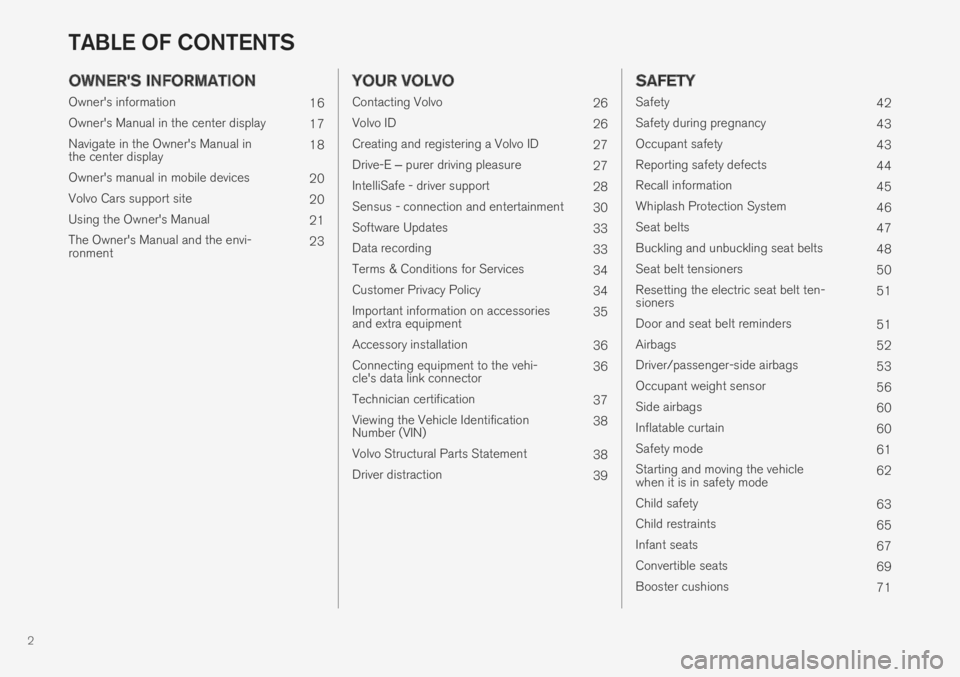
2
OWNER'S INFORMATION
Owner's information16
Owner's Manual in the center display17
Navigate in the Owner's Manual inthe center display18
Owner's manual in mobile devices20
Volvo Cars support site20
Using the Owner's Manual21
The Owner's Manual and the envi-ronment23
YOUR VOLVO
Contacting Volvo26
Volvo ID26
Creating and registering a Volvo ID27
Drive-E ‒ purer driving pleasure27
IntelliSafe - driver support28
Sensus - connection and entertainment30
Software Updates33
Data recording33
Terms & Conditions for Services34
Customer Privacy Policy34
Important information on accessoriesand extra equipment35
Accessory installation36
Connecting equipment to the vehi-cle's data link connector36
Technician certification37
Viewing the Vehicle IdentificationNumber (VIN)38
Volvo Structural Parts Statement38
Driver distraction39
SAFETY
Safety42
Safety during pregnancy43
Occupant safety43
Reporting safety defects44
Recall information45
Whiplash Protection System46
Seat belts47
Buckling and unbuckling seat belts48
Seat belt tensioners50
Resetting the electric seat belt ten-sioners51
Door and seat belt reminders51
Airbags52
Driver/passenger-side airbags53
Occupant weight sensor56
Side airbags60
Inflatable curtain60
Safety mode61
Starting and moving the vehiclewhen it is in safety mode62
Child safety63
Child restraints65
Infant seats67
Convertible seats69
Booster cushions71
TABLE OF CONTENTS
Page 9 of 686
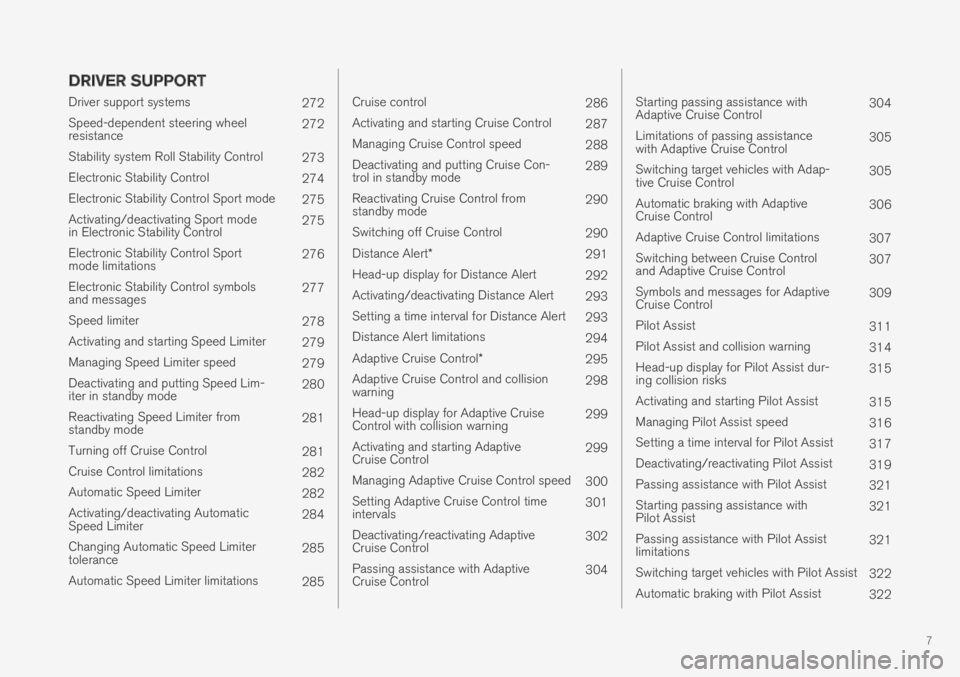
7
DRIVER SUPPORT
Driver support systems272
Speed-dependent steering wheelresistance272
Stability system Roll Stability Control273
Electronic Stability Control274
Electronic Stability Control Sport mode275
Activating/deactivating Sport modein Electronic Stability Control275
Electronic Stability Control Sportmode limitations276
Electronic Stability Control symbolsand messages277
Speed limiter278
Activating and starting Speed Limiter279
Managing Speed Limiter speed279
Deactivating and putting Speed Lim-iter in standby mode280
Reactivating Speed Limiter fromstandby mode281
Turning off Cruise Control281
Cruise Control limitations282
Automatic Speed Limiter282
Activating/deactivating AutomaticSpeed Limiter284
Changing Automatic Speed Limitertolerance285
Automatic Speed Limiter limitations285
Cruise control286
Activating and starting Cruise Control287
Managing Cruise Control speed288
Deactivating and putting Cruise Con-trol in standby mode289
Reactivating Cruise Control fromstandby mode290
Switching off Cruise Control290
Distance Alert*291
Head-up display for Distance Alert292
Activating/deactivating Distance Alert293
Setting a time interval for Distance Alert293
Distance Alert limitations294
Adaptive Cruise Control*295
Adaptive Cruise Control and collisionwarning298
Head-up display for Adaptive CruiseControl with collision warning299
Activating and starting AdaptiveCruise Control299
Managing Adaptive Cruise Control speed300
Setting Adaptive Cruise Control timeintervals301
Deactivating/reactivating AdaptiveCruise Control302
Passing assistance with AdaptiveCruise Control304
Starting passing assistance withAdaptive Cruise Control304
Limitations of passing assistancewith Adaptive Cruise Control305
Switching target vehicles with Adap-tive Cruise Control305
Automatic braking with AdaptiveCruise Control306
Adaptive Cruise Control limitations307
Switching between Cruise Controland Adaptive Cruise Control307
Symbols and messages for AdaptiveCruise Control309
Pilot Assist311
Pilot Assist and collision warning314
Head-up display for Pilot Assist dur-ing collision risks315
Activating and starting Pilot Assist315
Managing Pilot Assist speed316
Setting a time interval for Pilot Assist317
Deactivating/reactivating Pilot Assist319
Passing assistance with Pilot Assist321
Starting passing assistance withPilot Assist321
Passing assistance with Pilot Assistlimitations321
Switching target vehicles with Pilot Assist322
Automatic braking with Pilot Assist322
Page 12 of 686
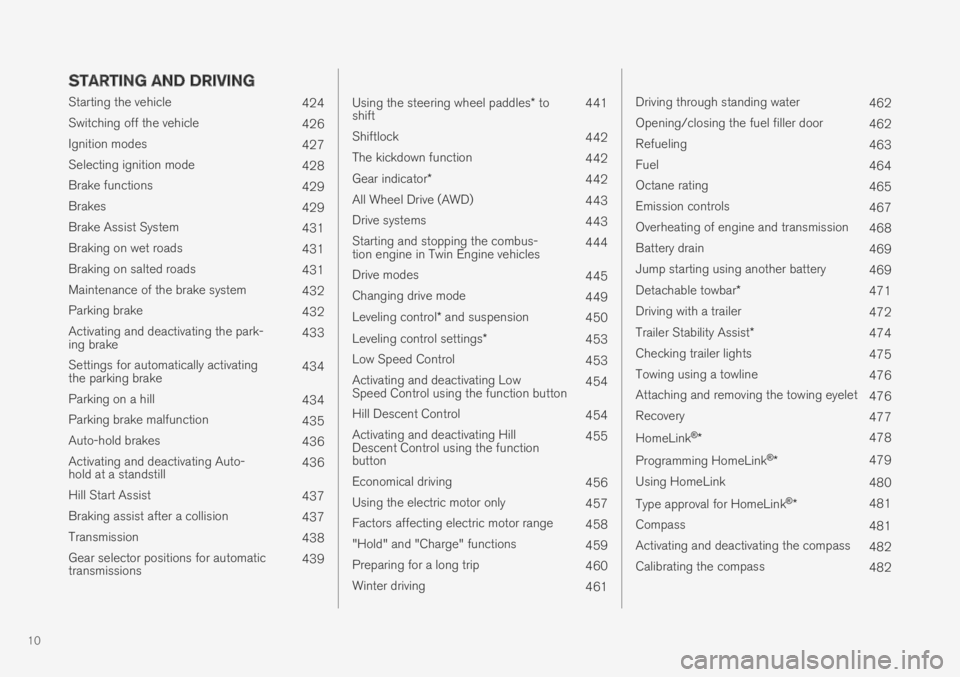
10
STARTING AND DRIVING
Starting the vehicle424
Switching off the vehicle426
Ignition modes427
Selecting ignition mode428
Brake functions429
Brakes429
Brake Assist System431
Braking on wet roads431
Braking on salted roads431
Maintenance of the brake system432
Parking brake432
Activating and deactivating the park-ing brake433
Settings for automatically activatingthe parking brake434
Parking on a hill434
Parking brake malfunction435
Auto-hold brakes436
Activating and deactivating Auto-hold at a standstill436
Hill Start Assist437
Braking assist after a collision437
Transmission438
Gear selector positions for automatictransmissions439
Using the steering wheel paddles* toshift441
Shiftlock442
The kickdown function442
Gear indicator*442
All Wheel Drive (AWD)443
Drive systems443
Starting and stopping the combus-tion engine in Twin Engine vehicles444
Drive modes445
Changing drive mode449
Leveling control* and suspension450
Leveling control settings*453
Low Speed Control453
Activating and deactivating LowSpeed Control using the function button454
Hill Descent Control454
Activating and deactivating HillDescent Control using the functionbutton
455
Economical driving456
Using the electric motor only457
Factors affecting electric motor range458
"Hold" and "Charge" functions459
Preparing for a long trip460
Winter driving461
Driving through standing water462
Opening/closing the fuel filler door462
Refueling463
Fuel464
Octane rating465
Emission controls467
Overheating of engine and transmission468
Battery drain469
Jump starting using another battery469
Detachable towbar*471
Driving with a trailer472
Trailer Stability Assist*474
Checking trailer lights475
Towing using a towline476
Attaching and removing the towing eyelet476
Recovery477
HomeLink®*478
Programming HomeLink®*479
Using HomeLink480
Type approval for HomeLink®*481
Compass481
Activating and deactivating the compass482
Calibrating the compass482
Page 30 of 686
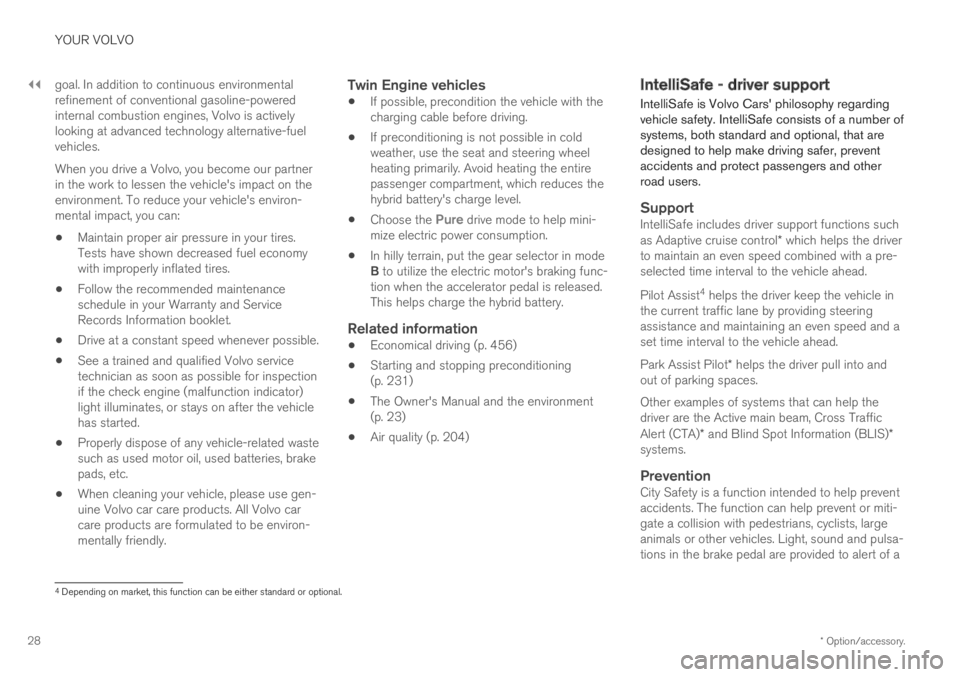
||
YOUR VOLVO
* Option/accessory.28
goal. In addition to continuous environmentalrefinement of conventional gasoline-poweredinternal combustion engines, Volvo is activelylooking at advanced technology alternative-fuelvehicles.
When you drive a Volvo, you become our partnerin the work to lessen the vehicle's impact on theenvironment. To reduce your vehicle's environ-mental impact, you can:
•Maintain proper air pressure in your tires.Tests have shown decreased fuel economywith improperly inflated tires.
•Follow the recommended maintenanceschedule in your Warranty and ServiceRecords Information booklet.
•Drive at a constant speed whenever possible.
•See a trained and qualified Volvo servicetechnician as soon as possible for inspectionif the check engine (malfunction indicator)light illuminates, or stays on after the vehiclehas started.
•Properly dispose of any vehicle-related wastesuch as used motor oil, used batteries, brakepads, etc.
•When cleaning your vehicle, please use gen-uine Volvo car care products. All Volvo carcare products are formulated to be environ-mentally friendly.
Twin Engine vehicles
•If possible, precondition the vehicle with thecharging cable before driving.
•If preconditioning is not possible in coldweather, use the seat and steering wheelheating primarily. Avoid heating the entirepassenger compartment, which reduces thehybrid battery's charge level.
•Choose the Pure drive mode to help mini-mize electric power consumption.
•In hilly terrain, put the gear selector in modeB to utilize the electric motor's braking func-tion when the accelerator pedal is released.This helps charge the hybrid battery.
Related information
•Economical driving (p. 456)
•Starting and stopping preconditioning(p. 231)
•The Owner's Manual and the environment(p. 23)
•Air quality (p. 204)
IntelliSafe - driver support
IntelliSafe is Volvo Cars' philosophy regardingvehicle safety. IntelliSafe consists of a number ofsystems, both standard and optional, that aredesigned to help make driving safer, preventaccidents and protect passengers and otherroad users.
Support
IntelliSafe includes driver support functions suchas Adaptive cruise control* which helps the driverto maintain an even speed combined with a pre-selected time interval to the vehicle ahead.
Pilot Assist4 helps the driver keep the vehicle inthe current traffic lane by providing steeringassistance and maintaining an even speed and aset time interval to the vehicle ahead.
Park Assist Pilot* helps the driver pull into andout of parking spaces.
Other examples of systems that can help thedriver are the Active main beam, Cross TrafficAlert (CTA)* and Blind Spot Information (BLIS)*systems.
Prevention
City Safety is a function intended to help preventaccidents. The function can help prevent or miti-gate a collision with pedestrians, cyclists, largeanimals or other vehicles. Light, sound and pulsa-tions in the brake pedal are provided to alert of a
4Depending on market, this function can be either standard or optional.
Page 35 of 686
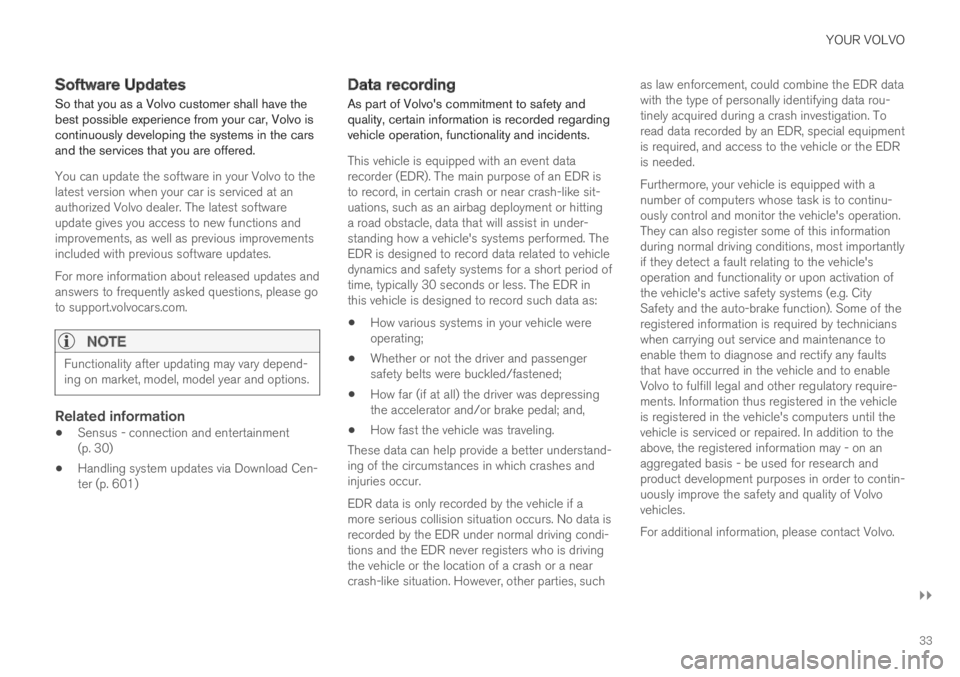
YOUR VOLVO
}}
33
Software Updates
So that you as a Volvo customer shall have thebest possible experience from your car, Volvo iscontinuously developing the systems in the carsand the services that you are offered.
You can update the software in your Volvo to thelatest version when your car is serviced at anauthorized Volvo dealer. The latest softwareupdate gives you access to new functions andimprovements, as well as previous improvementsincluded with previous software updates.
For more information about released updates andanswers to frequently asked questions, please goto support.volvocars.com.
NOTE
Functionality after updating may vary depend-ing on market, model, model year and options.
Related information
•Sensus - connection and entertainment(p. 30)
•Handling system updates via Download Cen-ter (p. 601)
Data recording
As part of Volvo's commitment to safety andquality, certain information is recorded regardingvehicle operation, functionality and incidents.
This vehicle is equipped with an event datarecorder (EDR). The main purpose of an EDR isto record, in certain crash or near crash-like sit-uations, such as an airbag deployment or hittinga road obstacle, data that will assist in under-standing how a vehicle's systems performed. TheEDR is designed to record data related to vehicledynamics and safety systems for a short period oftime, typically 30 seconds or less. The EDR inthis vehicle is designed to record such data as:
•How various systems in your vehicle wereoperating;
•Whether or not the driver and passengersafety belts were buckled/fastened;
•How far (if at all) the driver was depressingthe accelerator and/or brake pedal; and,
•How fast the vehicle was traveling.
These data can help provide a better understand-ing of the circumstances in which crashes andinjuries occur.
EDR data is only recorded by the vehicle if amore serious collision situation occurs. No data isrecorded by the EDR under normal driving condi-tions and the EDR never registers who is drivingthe vehicle or the location of a crash or a nearcrash-like situation. However, other parties, such
as law enforcement, could combine the EDR datawith the type of personally identifying data rou-tinely acquired during a crash investigation. Toread data recorded by an EDR, special equipmentis required, and access to the vehicle or the EDRis needed.
Furthermore, your vehicle is equipped with anumber of computers whose task is to continu-ously control and monitor the vehicle's operation.They can also register some of this informationduring normal driving conditions, most importantlyif they detect a fault relating to the vehicle'soperation and functionality or upon activation ofthe vehicle's active safety systems (e.g. CitySafety and the auto-brake function). Some of theregistered information is required by technicianswhen carrying out service and maintenance toenable them to diagnose and rectify any faultsthat have occurred in the vehicle and to enableVolvo to fulfill legal and other regulatory require-ments. Information thus registered in the vehicleis registered in the vehicle's computers until thevehicle is serviced or repaired. In addition to theabove, the registered information may - on anaggregated basis - be used for research andproduct development purposes in order to contin-uously improve the safety and quality of Volvovehicles.
For additional information, please contact Volvo.
Page 44 of 686
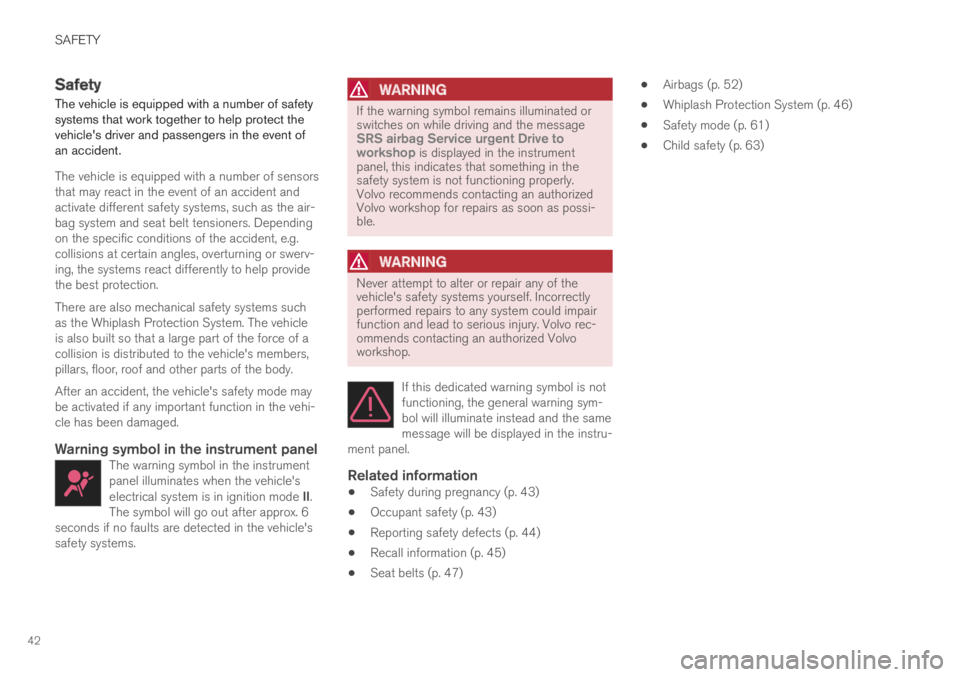
SAFETY
42
Safety
The vehicle is equipped with a number of safetysystems that work together to help protect thevehicle's driver and passengers in the event ofan accident.
The vehicle is equipped with a number of sensorsthat may react in the event of an accident andactivate different safety systems, such as the air-bag system and seat belt tensioners. Dependingon the specific conditions of the accident, e.g.collisions at certain angles, overturning or swerv-ing, the systems react differently to help providethe best protection.
There are also mechanical safety systems suchas the Whiplash Protection System. The vehicleis also built so that a large part of the force of acollision is distributed to the vehicle's members,pillars, floor, roof and other parts of the body.
After an accident, the vehicle's safety mode maybe activated if any important function in the vehi-cle has been damaged.
Warning symbol in the instrument panel
The warning symbol in the instrumentpanel illuminates when the vehicle'selectrical system is in ignition mode II.The symbol will go out after approx. 6seconds if no faults are detected in the vehicle'ssafety systems.
WARNING
If the warning symbol remains illuminated orswitches on while driving and the messageSRS airbag Service urgent Drive toworkshop is displayed in the instrumentpanel, this indicates that something in thesafety system is not functioning properly.Volvo recommends contacting an authorizedVolvo workshop for repairs as soon as possi-ble.
WARNING
Never attempt to alter or repair any of thevehicle's safety systems yourself. Incorrectlyperformed repairs to any system could impairfunction and lead to serious injury. Volvo rec-ommends contacting an authorized Volvoworkshop.
If this dedicated warning symbol is notfunctioning, the general warning sym-bol will illuminate instead and the samemessage will be displayed in the instru-ment panel.
Related information
•Safety during pregnancy (p. 43)
•Occupant safety (p. 43)
•Reporting safety defects (p. 44)
•Recall information (p. 45)
•Seat belts (p. 47)
•Airbags (p. 52)
•Whiplash Protection System (p. 46)
•Safety mode (p. 61)
•Child safety (p. 63)
Page 63 of 686
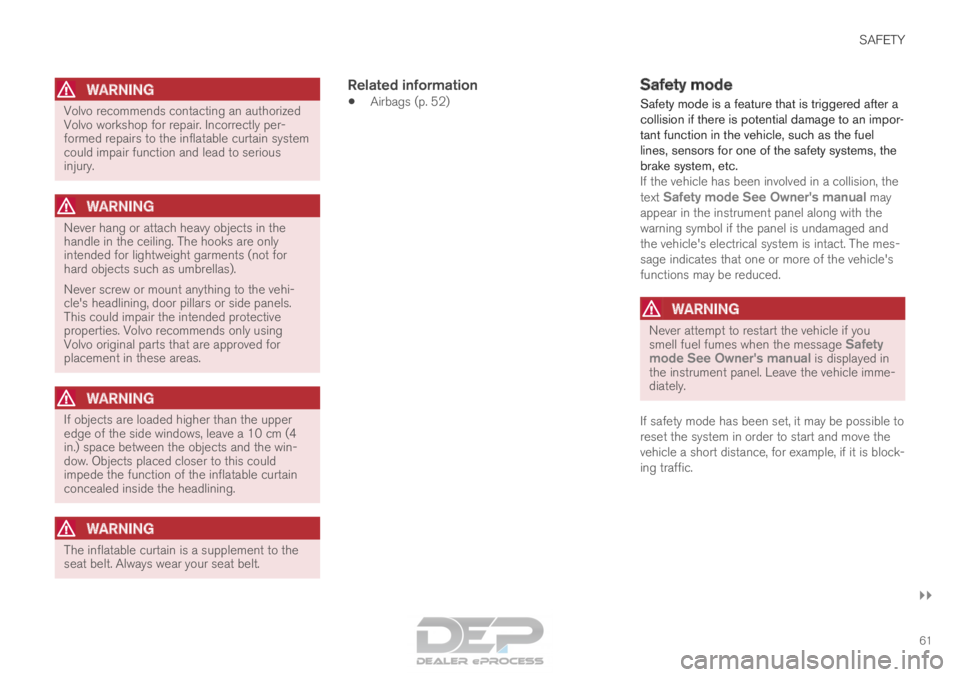
SAFETY
}}61
WARNING Volvo recommends contacting an authorized
Volvo workshop for repair. Incorrectly per-
formed repairs to the inflatable curtain system
could impair function and lead to serious
injury.
WARNING
Never hang or attach heavy objects in the
handle in the ceiling. The hooks are only
intended for lightweight garments (not for
hard objects such as umbrellas).
Never screw or mount anything to the vehi-
cle's headlining, door pillars or side panels.
This could impair the intended protective
properties. Volvo recommends only using
Volvo original parts that are approved for
placement in these areas.
WARNING
If objects are loaded higher than the upper
edge of the side windows, leave a 10 cm (4
in.) space between the objects and the win-
dow. Objects placed closer to this could
impede the function of the inflatable curtain
concealed inside the headlining.
WARNING
The inflatable curtain is a supplement to the
seat belt. Always wear your seat belt.
Related information
•
Airbags (p. 52) Safety mode
Safety mode is a feature that is triggered after a
collision if there is potential damage to an impor-
tant function in the vehicle, such as the fuel
lines, sensors for one of the safety systems, the
brake system, etc.
If the vehicle has been involved in a collision, the
text
Safety mode See Owner's manual may
appear in the instrument panel along with the
warning symbol if the panel is undamaged and
the vehicle's electrical system is intact. The mes-
sage indicates that one or more of the vehicle's
functions may be reduced.
WARNING Never attempt to restart the vehicle if you
smell fuel fumes when the message
Safety
mode See Owner's manual is displayed in the instrument panel. Leave the vehicle imme-
diately.
If safety mode has been set, it may be possible to
reset the system in order to start and move the
vehicle a short distance, for example, if it is block-
ing traffic.
Page 64 of 686

||SAFETY
62
WARNING
Never attempt to perform repairs or reset
electrical components on your own after the
vehicle has been in safety mode. This could
result in injury or prevent the vehicle from
functioning properly. Volvo recommends hav-
ing the vehicle inspected and reset to normal
operating status by an authorized Volvo work-
shop after
Safety mode See Owner's
manual has been displayed.
WARNING When the vehicle is in safety mode, it should
not be towed behind another vehicle. It should
be towed from the site on a tow truck. Volvo
recommends towing the vehicle directly to an
authorized Volvo workshop.
Related information
•
Safety (p. 42)
• Starting and moving the vehicle when it is in
safety mode (p. 62)
• Recovery (p. 477) Starting and moving the vehicle
when it is in safety mode
If safety mode has been set, it may be possible
to reset the system in order to start and move
the vehicle a short distance, for example, if it is
blocking traffic.
Starting the vehicle when it is in safety
mode
1. Check the vehicle for damage, particularly for
fuel leakage. Make sure you do not detect
any gasoline fumes.
If the damage to the vehicle is minor and
there is no fuel leakage/fumes, you may
attempt to start the engine.
WARNING Never attempt to restart the vehicle if you
smell fuel fumes when the message
Safety
mode See Owner's manual is displayed in the instrument panel. Leave the vehicle imme-
diately.
2.
Switch off the ignition.
3. Then try to start the vehicle. >The message Vehicle start System
check, wait will appear in the instrument
panel while the electrical system performs
a system check and then attempts to
reset to normal operating mode. This may
take up to a minute. 4.
When Vehicle start System check, wait is
no longer displayed in the instrument panel,
try again to start the vehicle.
CAUTION If the message
Safety mode See Owner's
manual is still displayed, the vehicle should not be driven or towed behind another vehi-
cle. If the vehicle needs to be moved, it must
be towed on a tow truck. Even if no damage
is apparent, there may be hidden damage that
could make the vehicle impossible to control.
Moving the vehicle when it is in safety
mode
1. If the message Normal mode The vehicle
is now in normal mode is displayed after
attempting to start the engine, the vehicle
may be moved carefully from its present
position if, for example, it is blocking traffic.
2.
Do not move the vehicle farther than abso-
lutely necessary.
WARNING When the vehicle is in safety mode, it should
not be towed behind another vehicle. It should
be towed from the site on a tow truck. Volvo
recommends towing the vehicle directly to an
authorized Volvo workshop.
Page 65 of 686
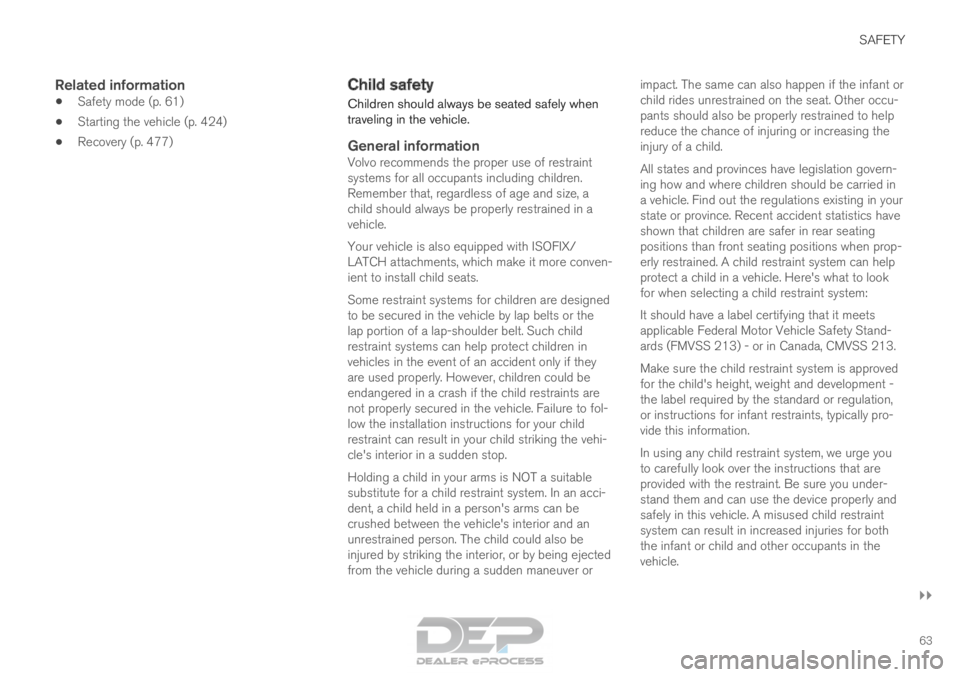
SAFETY
}}63
Related information
• Safety mode (p. 61)
• Starting the vehicle (p. 424)
• Recovery (p. 477) Child safety
Children should always be seated safely when
traveling in the vehicle.
General informationVolvo recommends the proper use of restraint
systems for all occupants including children.
Remember that, regardless of age and size, a
child should always be properly restrained in a
vehicle.
Your vehicle is also equipped with ISOFIX/
LATCH attachments, which make it more conven-
ient to install child seats.
Some restraint systems for children are designed
to be secured in the vehicle by lap belts or the
lap portion of a lap-shoulder belt. Such child
restraint systems can help protect children in
vehicles in the event of an accident only if they
are used properly. However, children could be
endangered in a crash if the child restraints are
not properly secured in the vehicle. Failure to fol-
low the installation instructions for your child
restraint can result in your child striking the vehi-
cle's interior in a sudden stop.
Holding a child in your arms is NOT a suitable
substitute for a child restraint system. In an acci-
dent, a child held in a person's arms can be
crushed between the vehicle's interior and an
unrestrained person. The child could also be
injured by striking the interior, or by being ejected
from the vehicle during a sudden maneuver or impact. The same can also happen if the infant or
child rides unrestrained on the seat. Other occu-
pants should also be properly restrained to help
reduce the chance of injuring or increasing the
injury of a child.
All states and provinces have legislation govern-
ing how and where children should be carried in
a vehicle. Find out the regulations existing in your
state or province. Recent accident statistics have
shown that children are safer in rear seating
positions than front seating positions when prop-
erly restrained. A child restraint system can help
protect a child in a vehicle. Here's what to look
for when selecting a child restraint system:
It should have a label certifying that it meets
applicable Federal Motor Vehicle Safety Stand-
ards (FMVSS 213) - or in Canada, CMVSS 213.
Make sure the child restraint system is approved
for the child's height, weight and development -
the label required by the standard or regulation,
or instructions for infant restraints, typically pro-
vide this information.
In using any child restraint system, we urge you
to carefully look over the instructions that are
provided with the restraint. Be sure you under-
stand them and can use the device properly and
safely in this vehicle. A misused child restraint
system can result in increased injuries for both
the infant or child and other occupants in the
vehicle.
Page 75 of 686
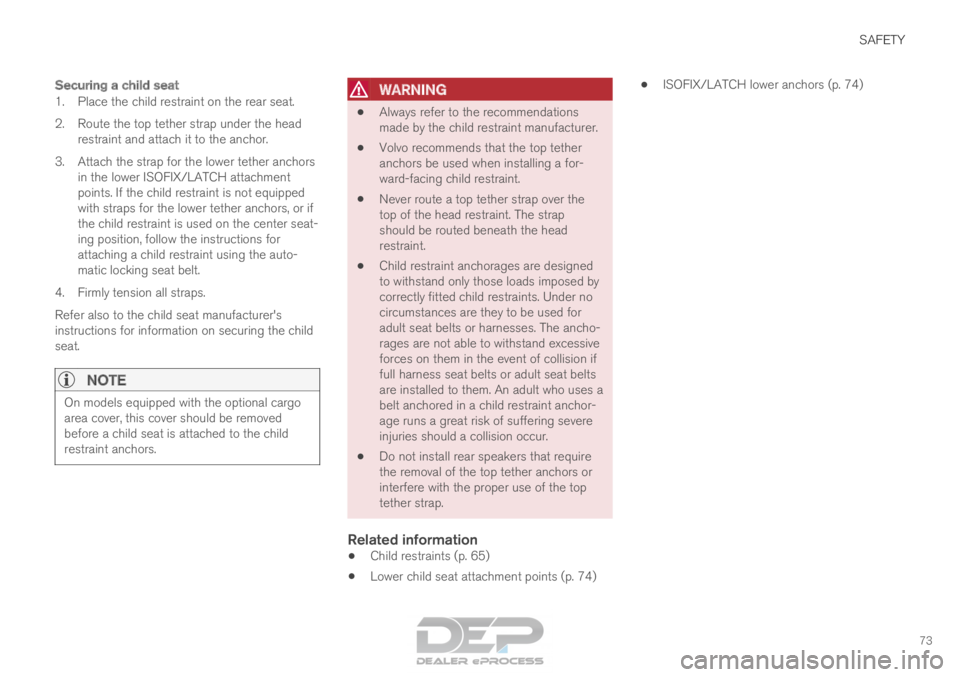
SAFETY
73
Securing a child seat
1. Place the child restraint on the rear seat.
2. Route the top tether strap under the headrestraint and attach it to the anchor.
3. Attach the strap for the lower tether anchors in the lower ISOFIX/LATCH attachment
points. If the child restraint is not equipped
with straps for the lower tether anchors, or if
the child restraint is used on the center seat-
ing position, follow the instructions for
attaching a child restraint using the auto-
matic locking seat belt.
4. Firmly tension all straps.
Refer also to the child seat manufacturer's
instructions for information on securing the child
seat.
NOTE On models equipped with the optional cargo
area cover, this cover should be removed
before a child seat is attached to the child
restraint anchors.
WARNING •
Always refer to the recommendations
made by the child restraint manufacturer.
• Volvo recommends that the top tether
anchors be used when installing a for-
ward-facing child restraint.
• Never route a top tether strap over the
top of the head restraint. The strap
should be routed beneath the head
restraint.
• Child restraint anchorages are designed
to withstand only those loads imposed by
correctly fitted child restraints. Under no
circumstances are they to be used for
adult seat belts or harnesses. The ancho-
rages are not able to withstand excessive
forces on them in the event of collision if
full harness seat belts or adult seat belts
are installed to them. An adult who uses a
belt anchored in a child restraint anchor-
age runs a great risk of suffering severe
injuries should a collision occur.
• Do not install rear speakers that require
the removal of the top tether anchors or
interfere with the proper use of the top
tether strap.
Related information
•Child restraints (p. 65)
• Lower child seat attachment points (p. 74) •
ISOFIX/LATCH lower anchors (p. 74)